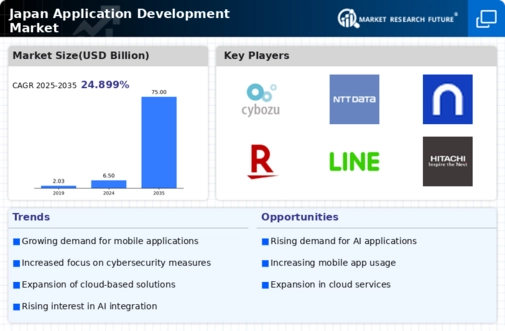Growing Demand for Custom Solutions
The application development market in Japan is experiencing a notable surge in demand for custom software solutions. Businesses are increasingly seeking tailored applications to meet specific operational needs, which drives innovation and investment in the sector. According to recent data, the custom software development segment is projected to grow at a CAGR of 8.5% through 2026. This trend is fueled by the need for enhanced user experiences and the desire to differentiate from competitors. As companies recognize the value of bespoke applications, the market is likely to see a proliferation of development firms specializing in custom solutions. This shift not only enhances the application development market but also encourages collaboration between businesses and developers, fostering a more dynamic ecosystem.
Expansion of Cloud Computing Services
The application development market in Japan is significantly influenced by the rapid expansion of cloud computing services. As organizations increasingly migrate to cloud-based platforms, the demand for applications that leverage these technologies is on the rise. Reports indicate that the cloud services market in Japan is expected to reach approximately $20 billion by 2025, with a substantial portion allocated to application development. This transition allows for greater scalability, flexibility, and cost-effectiveness, which are essential for modern businesses. Consequently, developers are focusing on creating applications that are optimized for cloud environments, thereby enhancing the overall efficiency and functionality of the application development market. This trend is likely to continue as more enterprises recognize the advantages of cloud integration.
Increased Focus on User-Centric Design
In the application development market, there is a marked shift towards user-centric design principles. Japanese consumers are becoming more discerning, demanding applications that are not only functional but also intuitive and aesthetically pleasing. This trend is prompting developers to invest in user experience (UX) research and design methodologies. As a result, applications that prioritize user engagement are likely to see higher adoption rates. Data suggests that applications with superior UX can increase user retention by up to 50%. This emphasis on design is reshaping the application development market, as companies strive to create products that resonate with users on a deeper level, ultimately driving growth and innovation in the sector.
Regulatory Compliance and Data Privacy
The application development market in Japan is increasingly shaped by stringent regulatory compliance and data privacy requirements. With the rise of data breaches and privacy concerns, developers are compelled to create applications that adhere to local regulations, such as the Act on the Protection of Personal Information (APPI). This regulatory landscape necessitates a focus on security features and data management practices within applications. Companies that prioritize compliance are likely to gain a competitive edge, as consumers are more inclined to trust applications that demonstrate a commitment to safeguarding their information. This trend is expected to drive investment in secure application development practices, thereby influencing the overall direction of the application development market.
Adoption of Agile Development Methodologies
The application development market in Japan is witnessing a significant shift towards agile development methodologies. This approach allows for more flexibility and responsiveness to changing market demands, which is crucial in a fast-paced technological landscape. Companies are increasingly adopting agile practices to enhance collaboration among development teams and stakeholders, leading to faster delivery times and improved product quality. Data indicates that organizations utilizing agile methodologies can reduce time-to-market by up to 30%. This trend is likely to continue as businesses recognize the benefits of agility in application development, fostering a more adaptive and innovative market environment.



















Leave a Comment